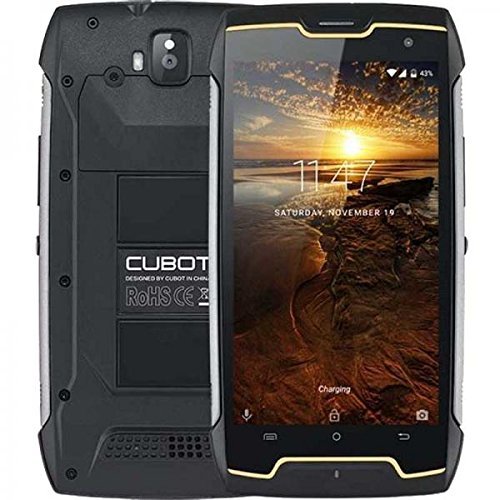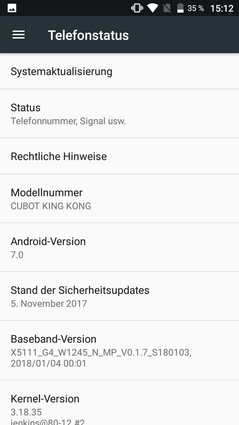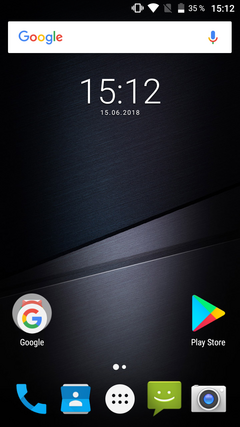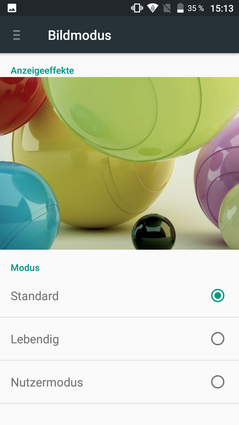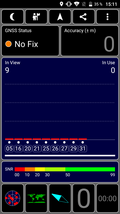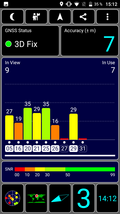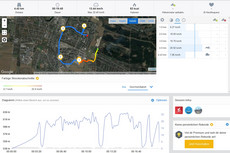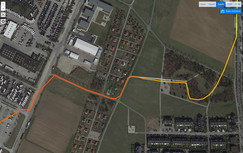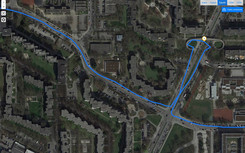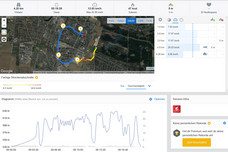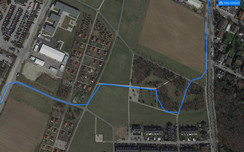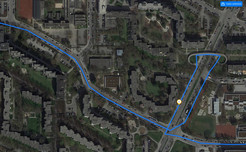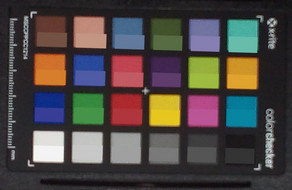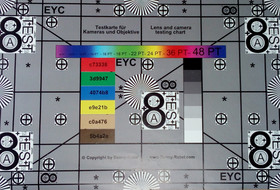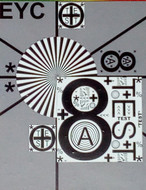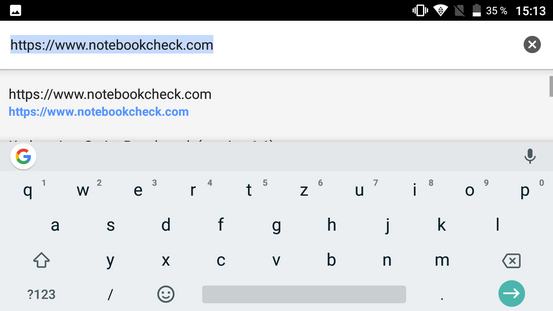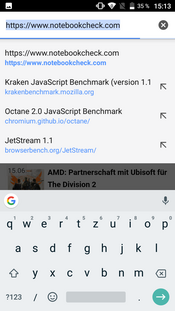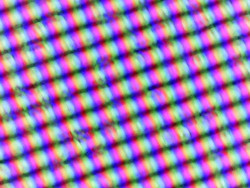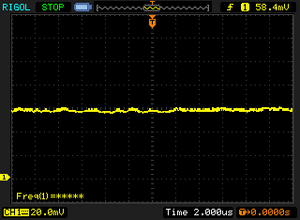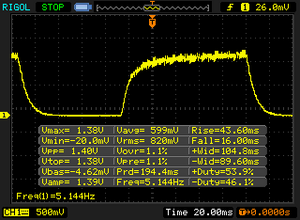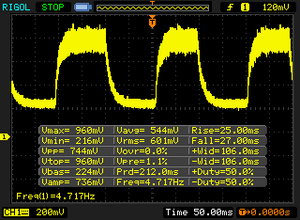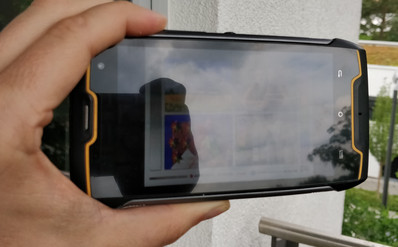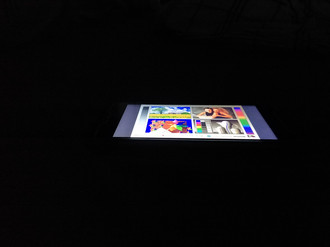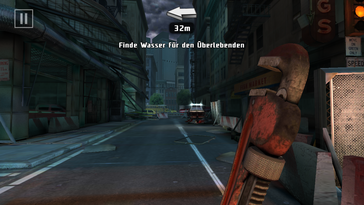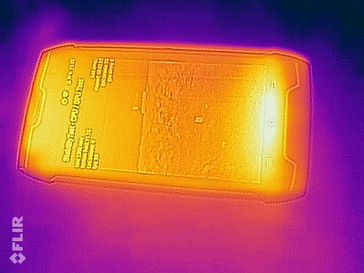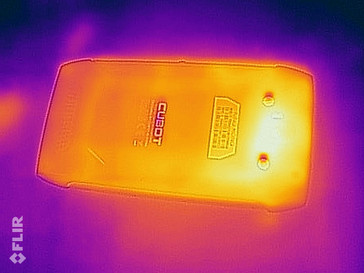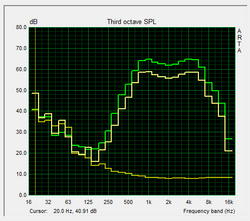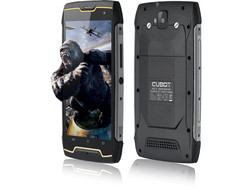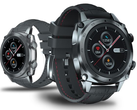Cubot King Kong Smartphone Review
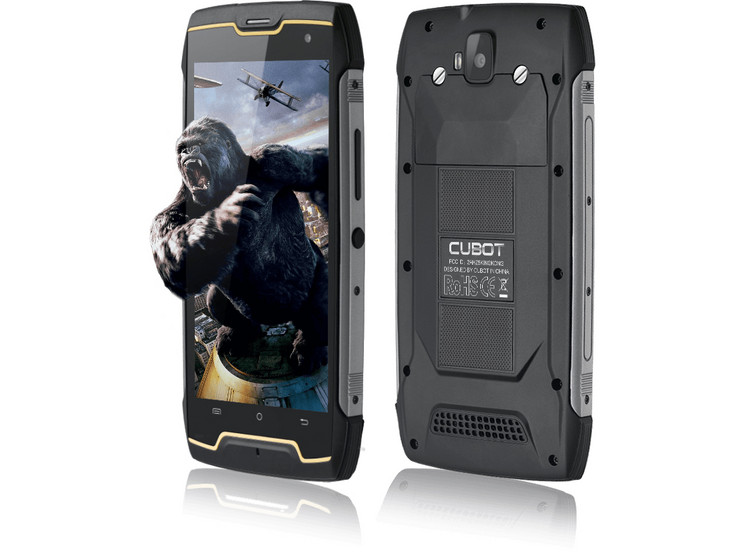
A famous name is always a good bet. Until now, the Chinese manufacturer Cubot has been more or less unknown in the western hemisphere. But the unusual names of their smartphones - Cubot Dinosaur or Cubot Magic, for example - might be about to change this.
The manufacturer's rugged smartphone is named after King Kong, the most famous ape in film history. The enormous animal had its first debut in 1933 and is still known among young cinema-enthusiasts today thanks to Peter Jackson. Here we have a robust mobile phone named King Kong - which, naturally, promises strength and resilience. The manufacturer has even had the device IP68-certified for dust and water-protection and wrapped it in a heavy and bulky plastic case.
But the Cubot King Kong must also compete with other outdoor smartphones such as the Cat S31, the Samsung Galaxy XCover 4, the Ulefone Armor X and the Oukitel WP5000. It already has one clear advantage: Its retail price of $120 is unbeatable for a tough smartphone. Let us find out whether the low price has an influence on the device's quality.
Case – metal and screws on the case
Similar to other robust smartphones, the Cubot King Kong has a very different appearance to beauties such as the Galaxy S9 or the OnePlus 6: As outdoor smartphones are aimed at people who spend a lot of time in difficult environments with dust, water or dirt that are not ideal for mobile phones, the case often looks a little rougher in order to underline this toughness. The cases of the Samsung Galaxy XCover 4 and the Cat S31 look a lot simpler but still have large hardware buttons and cases that offer a good grip.
The Cubot King Kong is a lot more "in-your-face": Like the Oukitel WP5000, it does everything to make it quite clear that it is a robust phone: visible screws, metal elements on the rims and a heavy weight. The device also features yellow decorative borders above and below the screen. The back of the device is not flat but becomes thicker towards the middle. The device is comfortable to hold but is quite large for a 5-inch smartphone.
According to the manufacturer, the case can resist pressure of up to one ton and temperatures between -35 °C and 60 °C. The screen, however, seems to be rather unprotected. It is not sunk into the case as it often is on other rugged smartphones. Users have already reported their screens breaking after being dropped for the first time.
The smartphone really is water-resistant and can be used under water thanks to the rubber parts that cover the port openings. Just make sure that these are always closed tight. Not so good: The Cubot King Kong does not offer any hardware buttons to access the menu. Users will have to rely on touch buttons, which might sometimes be difficult to use, for example if you are wearing gloves.
The SIM slots are only accessible after removing two screws. We would recommend using your own screwdriver to unscrew these, as the included tool is a little fiddly to work with.
Connectivity – a microSD slot and dual SIM
The Cubot King Kong has two SIM slots and also offers a separate microSD card reader. Inserting a microSD card means restarting the phone, as the card will not be recognized otherwise. On top of that, the smartphone did not get along with our reference card Toshiba Exceria Pro M501. Luckily, it worked with a different 32-GB microSD card.
Apart from this, the connectivity is representative for the device's price. At least Cubot has included a geomagnetic sensor that can be used as a compass.
Software – pure Android 7 in the Cubot King Kong
We appreciate that the Cubot offers pure Android 7 instead of being equipped with a separate version of Android. Do not expect a newer version of Android to become available. The security patch from November 2017 is also rather dated. The device does not have any additional apps and users are free to set their device up the way they like it. Be aware that due to the limitations of the SoC and graphics unit, not all apps on Google Play are available for this phone. Google does not even display incompatible apps in your search. Some affected apps are the 3D components of the AnTuTu benchmarks or other apps that use modern graphic interfaces.
Communication and GPS – no LTE
The Cubot King Kong has one rather big disadvantage that is very rare even for smartphones that cost $120: It does not support LTE. However, it does support all the necessary GSM and UMTS networks and reception is decent even indoors.
The Wi-Fi is not ideal either, but this is more common in this price range. For example, the phone does not support the 5-GHz Wi-Fi networks. The significantly more expensive Cat S31 does not support this rare, and therefore faster, band either. The fastest supported protocol is 802.11 n. Our test unit did quite well in the Wi-Fi test with our reference router Linksys EA8500. It is significantly faster than the Cat S31 or the Samsung Galaxy XCover 4.
| Networking | |
| iperf3 transmit AX12 | |
| Oukitel WP5000 | |
| Ulefone Armor X | |
| Cubot King Kong | |
| CAT S31 | |
| Samsung Galaxy XCover 4 | |
| iperf3 receive AX12 | |
| Oukitel WP5000 | |
| Ulefone Armor X | |
| Cubot King Kong | |
| Samsung Galaxy XCover 4 | |
| CAT S31 | |
The smartphone was not able to locate us indoors. It needed a while outdoors, but then located us within seven meters, which is fine.
In our practical test, we took the Cubot King Kong on a bike ride together with the professional navigator Garmin Edge 520 and compared the results. The professional device is a lot more precise and you can even tell on which side of the road we were on while the Cubot King Kong is less exact. However, its performance should be sufficient for occasional use. The Cubot smartphone also has a compass, which is good for this price range.
Telephone and Call Quality – good
The manufacturer has used Android's own, easy-to-use telephone app.
The call quality is good: The internal earpiece reproduces our caller's voice quite clearly and our voice is picked up nicely by the microphone, even when talking quietly. On speakerphone, sounds continue to be transmitted clearly, although the microphone had some difficulties when we were speaking quietly. We could still hear our caller clearly.
Cameras – bleak prospects
A 13MP lens on the back and an 8MP front camera sound quite good considering the device's price. However, the image quality is mediocre at best: The main camera takes washed-out, grainy photos. Light areas are overemphasized, and the colors have a distinct blue cast. You can hardly recognize anything when the photos are taken in low lighting and sharpness could be better too. The main camera records videos at 720p, but these are also often blurred.
Photos taken with the main camera have similar issues.
The grainy image display does not improve under controlled lighting in our lab. Text on red background lacks contrast, areas of color appear pixelated and the edges are not clearly defined.
Surprisingly, colors are reproduced quite accurately, but then the images are so blurry and grainy that it is hard to recognize the real color shade.
Accessories and Warranty – available despite phone coming from China
Apart from a power supply and a USB cable, you will get a quick-start guide as well as a tool to open the screws of the SIM cover with the phone.
Warranty is often an issue when importing Chinese smartphones if the manufacturer is not yet represented outside of the country, as is the case with Cubot. However, the smartphone can easily be purchased via large dealers, so you should be protected by their warranty. Please see our Guarantees, Return policies and Warranties FAQ for country-specific information.
Input Devices & Handling – screen protector limits gliding capacity
The touchscreen of the Cubot phone already comes with a screen protector that is difficult to remove. It might not look particularly good but does offer additional protection. Unfortunately, it also influences the gliding capacity and you can feel some resistance when moving your finger over the screen.
The large hardware buttons on the right side of the case adjust the volume and turn the smartphone to standby. They are easy to find and have a good pressure point. However, the only way to control the operating system is by using touch buttons, which could pose some difficulties when wearing gloves.
The Cubot King does not have a fingerprint reader.
Display – a 720p screen
You cannot expect a resolution over 1280x720 pixels from a device in this price range. The Cubot King Kong uses the 16:9 display format, which could almost be called outdated nowadays, and it is five inches large. Despite the weighty case, the display itself is not very large.
The brightness of the screen is average at 449 cd/m². This cannot compare with the extremely bright display that can be found in the CAT S31 and is made particularly with outdoor use in mind. The brightness distribution is quite good at 90% and large areas of color appear uniform.
Excuse us for the blurry photo of the subpixel array - this is probably due to the screen protector.
| |||||||||||||||||||||||||
Brightness Distribution: 90 %
Center on Battery: 466 cd/m²
Contrast: 1864:1 (Black: 0.25 cd/m²)
ΔE ColorChecker Calman: 7.03 | ∀{0.5-29.43 Ø4.77}
ΔE Greyscale Calman: 7.1 | ∀{0.09-98 Ø5}
91.8% sRGB (Calman 2D)
Gamma: 2.26
CCT: 7244 K
| Cubot King Kong IPS, 1280x720, 5" | Oukitel WP5000 IPS, 1440x720, 5.7" | CAT S31 IPS, 1280x720, 4.7" | Samsung Galaxy XCover 4 IPS, 1280x720, 5" | Ulefone Armor X IPS, 1440x720, 5.5" | |
|---|---|---|---|---|---|
| Screen | -60% | 19% | -25% | 9% | |
| Brightness middle (cd/m²) | 466 | 506 9% | 784 68% | 445 -5% | 564 21% |
| Brightness (cd/m²) | 449 | 503 12% | 750 67% | 437 -3% | 541 20% |
| Brightness Distribution (%) | 90 | 86 -4% | 92 2% | 88 -2% | 91 1% |
| Black Level * (cd/m²) | 0.25 | 0.97 -288% | 0.45 -80% | 0.67 -168% | 0.37 -48% |
| Contrast (:1) | 1864 | 522 -72% | 1742 -7% | 664 -64% | 1524 -18% |
| Colorchecker dE 2000 * | 7.03 | 9.4 -34% | 4.28 39% | 6.5 8% | 5.1 27% |
| Colorchecker dE 2000 max. * | 16.25 | 19.9 -22% | 8.75 46% | 10.6 35% | 9.6 41% |
| Greyscale dE 2000 * | 7.1 | 13 -83% | 6.1 14% | 7.2 -1% | 5.4 24% |
| Gamma | 2.26 97% | 2.59 85% | 2.49 88% | 2.53 87% | 2.1 105% |
| CCT | 7244 90% | 10219 64% | 7175 91% | 8274 79% | 7755 84% |
* ... smaller is better
Screen Flickering / PWM (Pulse-Width Modulation)
| Screen flickering / PWM not detected | |||
In comparison: 53 % of all tested devices do not use PWM to dim the display. If PWM was detected, an average of 8081 (minimum: 5 - maximum: 343500) Hz was measured. | |||
The slow response rates make the screen unsuitable for gamers - apart from the fact that the device's performance could hardly keep up anyway, as we will see below. The black value is quite low at 0.25 cd/m² and black surfaces appear deep and dark. The resulting contrast ratio is the best of all comparison devices (1864:1).
While testing with the spectrophotometer and CalMAN software, we measured a significant purple cast. Particularly blue tones are very inaccurate.
Display Response Times
| ↔ Response Time Black to White | ||
|---|---|---|
| 59 ms ... rise ↗ and fall ↘ combined | ↗ 43 ms rise | |
| ↘ 16 ms fall | ||
| The screen shows slow response rates in our tests and will be unsatisfactory for gamers. In comparison, all tested devices range from 0.1 (minimum) to 240 (maximum) ms. » 99 % of all devices are better. This means that the measured response time is worse than the average of all tested devices (20.2 ms). | ||
| ↔ Response Time 50% Grey to 80% Grey | ||
| 52 ms ... rise ↗ and fall ↘ combined | ↗ 25 ms rise | |
| ↘ 27 ms fall | ||
| The screen shows slow response rates in our tests and will be unsatisfactory for gamers. In comparison, all tested devices range from 0.165 (minimum) to 636 (maximum) ms. » 88 % of all devices are better. This means that the measured response time is worse than the average of all tested devices (31.6 ms). | ||
Performance – the Cubot does not have a lot of power
The MediaTek MT6580M is an SoC made for simple smartphones and tablets and can be found in our test unit. It will not award the Cubot King Kong any points in the area of performance but should suffice for smooth navigating through the system. However, we did encounter occasional freezes and dropped frames. Our device's performance capacity can be compared with that of the CAT S31. Both are positioned in the bottom half of our comparison table. If you are looking for significantly higher performance, you should take a look at the Oukitel WP5000.
The graphics unit is no better: The ARM Mali-400 MP2 no longer supports many of the current graphic interfaces and certain apps or benchmarks are not even displayed in the Google Play store as they would not work on the phone anyway. For example, the device does not support Open GL 3.0 or above, nor Vulcan. In the benchmarks that we were able to run, the device remains one of the slower competitors.
| AnTuTu v6 - Total Score (sort by value) | |
| Cubot King Kong | |
| Oukitel WP5000 | |
| CAT S31 | |
| Samsung Galaxy XCover 4 | |
| Ulefone Armor X | |
| Average Mediatek MT6580M (15185 - 25237, n=10) | |
| AnTuTu v7 - Total Score (sort by value) | |
| Cubot King Kong | |
| Oukitel WP5000 | |
| Ulefone Armor X | |
| Average Mediatek MT6580M (17073 - 21088, n=4) | |
| PCMark for Android | |
| Work performance score (sort by value) | |
| Cubot King Kong | |
| Oukitel WP5000 | |
| CAT S31 | |
| Samsung Galaxy XCover 4 | |
| Ulefone Armor X | |
| Average Mediatek MT6580M (2516 - 3041, n=12) | |
| Work 2.0 performance score (sort by value) | |
| Cubot King Kong | |
| Oukitel WP5000 | |
| CAT S31 | |
| Samsung Galaxy XCover 4 | |
| Ulefone Armor X | |
| Average Mediatek MT6580M (0 - 0, n=2) | |
| 3DMark | |
| 1280x720 offscreen Ice Storm Unlimited Score (sort by value) | |
| Cubot King Kong | |
| Oukitel WP5000 | |
| CAT S31 | |
| Samsung Galaxy XCover 4 | |
| Ulefone Armor X | |
| Average Mediatek MT6580M (2841 - 2946, n=12) | |
| 1280x720 offscreen Ice Storm Unlimited Graphics Score (sort by value) | |
| Cubot King Kong | |
| Oukitel WP5000 | |
| CAT S31 | |
| Samsung Galaxy XCover 4 | |
| Ulefone Armor X | |
| Average Mediatek MT6580M (2396 - 2485, n=12) | |
| 1280x720 offscreen Ice Storm Unlimited Physics (sort by value) | |
| Cubot King Kong | |
| Oukitel WP5000 | |
| CAT S31 | |
| Samsung Galaxy XCover 4 | |
| Ulefone Armor X | |
| Average Mediatek MT6580M (7498 - 8913, n=12) | |
The Cubot King Kong requires some patience while surfing the web: It takes quite some time to load websites and images often need even longer to appear. Our benchmarks confirm this impression and place the smartphone towards the bottom of our comparison table.
| JetStream 1.1 - Total Score | |
| Oukitel WP5000 (Chrome 66) | |
| Samsung Galaxy XCover 4 (Chrome 58) | |
| Ulefone Armor X (Chrome 66) | |
| Average Mediatek MT6580M (10.8 - 14.5, n=10) | |
| Cubot King Kong (Chrome 66) | |
| CAT S31 | |
| Octane V2 - Total Score | |
| Average of class Smartphone (2228 - 126661, n=195, last 2 years) | |
| Oukitel WP5000 (Chrome 66) | |
| Ulefone Armor X (Chrome 66) | |
| Samsung Galaxy XCover 4 (Chrome 58) | |
| Cubot King Kong (Chrome 66) | |
| Average Mediatek MT6580M (1645 - 2280, n=10) | |
| CAT S31 | |
| Mozilla Kraken 1.1 - Total | |
| Cubot King Kong (Chrome 66) | |
| CAT S31 | |
| Average Mediatek MT6580M (14579 - 21257, n=11) | |
| Ulefone Armor X (Chrome 66) | |
| Samsung Galaxy XCover 4 (Chrome 58) | |
| Oukitel WP5000 (Chrome 66) | |
| Average of class Smartphone (257 - 28190, n=155, last 2 years) | |
* ... smaller is better
As mentioned above, our reference card Toshiba Exceria Pro M501 does not work in this device, which forced us to use a simple 32-GB card. The results might therefore not be 100% comparable, but they do show that, again, the Cubot King Kong is rather slow when reading and writing microSD cards. Accessing internal storage is no different.
| Cubot King Kong | Oukitel WP5000 | CAT S31 | Samsung Galaxy XCover 4 | Ulefone Armor X | Average 16 GB eMMC Flash | Average of class Smartphone | |
|---|---|---|---|---|---|---|---|
| AndroBench 3-5 | 177% | 159% | 172% | 203% | 110% | 3739% | |
| Sequential Read 256KB (MB/s) | 77.3 | 257.5 233% | 71.1 -8% | 181.6 135% | 255.3 230% | 164.5 ? 113% | 2246 ? 2806% |
| Sequential Write 256KB (MB/s) | 32.6 | 162.1 397% | 62.1 90% | 73.6 126% | 82.8 154% | 43 ? 32% | 1882 ? 5673% |
| Random Read 4KB (MB/s) | 17.2 | 66.9 289% | 14.28 -17% | 21.8 27% | 14.7 -15% | 21.7 ? 26% | 298 ? 1633% |
| Random Write 4KB (MB/s) | 7 | 9.89 41% | 14.81 112% | 11.9 70% | 10.17 45% | 8.08 ? 15% | 346 ? 4843% |
| Sequential Read 256KB SDCard (MB/s) | 20.6 ? | 21.11 ? 2% | 81.8 297% | 69 ? 235% | 81.5 ? 296% | 59.1 ? 187% | |
| Sequential Write 256KB SDCard (MB/s) | 10.3 ? | 20.5 ? 99% | 59.5 478% | 55.7 ? 441% | 62.6 ? 508% | 39.8 ? 286% |
Games – simple games are OK
Simple games such as Angry Birds are displayed smoothly and even 3D games such as Dead Trigger 2 can be played, although you will have to forego certain effects as the graphics card does not support modern interfaces. Even more-demanding games can be played thanks, in part, to the low screen resolution. Hardcore mobile gamers will not be pleased with this weak device as it is not possible to avoid occasional hiccups and frame drops.
We had no issues controlling the device with the gyroscope and the touchscreen.
Emissions – low temperatures, tolerable speaker
Temperature
The case heats up to a maximum of 36.9 °C under strong load. This is noticeable but not a problem. This hot spot is limited to the top area on the back of the phone. Maximum temperatures are a few degrees lower while idling.
(+) The maximum temperature on the upper side is 34.9 °C / 95 F, compared to the average of 35.2 °C / 95 F, ranging from 21.9 to 247 °C for the class Smartphone.
(+) The bottom heats up to a maximum of 36.9 °C / 98 F, compared to the average of 34 °C / 93 F
(+) In idle usage, the average temperature for the upper side is 31 °C / 88 F, compared to the device average of 32.9 °C / 91 F.
Speakers
The single speaker on the back of the Cubot King Kong is not particularly loud and therefore cannot be used in loud surroundings. Due to the weighty case, you can place the smartphone on the table without affecting the sound. Low mids are slightly too weak at maximum volume. At least the very high highs are not very pronounced either, which makes the overall sound passable. Demanding music lovers, however, would be better off using headphones or external speakers. Connecting these via Bluetooth is easy and works well with sound being transmitted very nicely. The same can be said for the 3.5-mm audio jack.
Cubot King Kong audio analysis
(±) | speaker loudness is average but good (74.4 dB)
Bass 100 - 315 Hz
(-) | nearly no bass - on average 52.9% lower than median
(+) | bass is linear (0% delta to prev. frequency)
Mids 400 - 2000 Hz
(-) | nearly no mids - on average 52.9% lower than median
(+) | mids are linear (0% delta to prev. frequency)
Highs 2 - 16 kHz
(-) | nearly no highs - on average 52.9% lower than median
(+) | highs are linear (0% delta to prev. frequency)
Overall 100 - 16.000 Hz
(-) | overall sound is not linear (113.1% difference to median)
Compared to same class
» 87% of all tested devices in this class were better, 2% similar, 11% worse
» The best had a delta of 11%, average was 35%, worst was 134%
Compared to all devices tested
» 96% of all tested devices were better, 1% similar, 3% worse
» The best had a delta of 4%, average was 24%, worst was 134%
Samsung Galaxy XCover 4 audio analysis
(±) | speaker loudness is average but good (80.4 dB)
Bass 100 - 315 Hz
(-) | nearly no bass - on average 15.9% lower than median
(±) | linearity of bass is average (12.3% delta to prev. frequency)
Mids 400 - 2000 Hz
(±) | higher mids - on average 7.4% higher than median
(+) | mids are linear (5.1% delta to prev. frequency)
Highs 2 - 16 kHz
(±) | higher highs - on average 6.3% higher than median
(+) | highs are linear (6.3% delta to prev. frequency)
Overall 100 - 16.000 Hz
(±) | linearity of overall sound is average (24.2% difference to median)
Compared to same class
» 56% of all tested devices in this class were better, 7% similar, 36% worse
» The best had a delta of 11%, average was 35%, worst was 134%
Compared to all devices tested
» 72% of all tested devices were better, 6% similar, 22% worse
» The best had a delta of 4%, average was 24%, worst was 134%
Battery Runtime
Power Consumption
The Cubot King Kong has decent power consumption. It consumes a maximum of 5.5 watts under maximum load, which is not the best result, but it is enough to score averagely compared to its competition. As the other consumption rates are quite low, its main competitor in the area of power consumption is the Samsung Galaxy XCover 4.
| Off / Standby | |
| Idle | |
| Load |
|
Key:
min: | |
| Cubot King Kong 4400 mAh | Oukitel WP5000 5200 mAh | CAT S31 4000 mAh | Samsung Galaxy XCover 4 2800 mAh | Ulefone Armor X 5500 mAh | Average Mediatek MT6580M | Average of class Smartphone | |
|---|---|---|---|---|---|---|---|
| Power Consumption | -28% | -4% | 0% | -30% | -14% | -38% | |
| Idle Minimum * (Watt) | 0.7 | 1.18 -69% | 0.73 -4% | 0.56 20% | 1.22 -74% | 0.805 ? -15% | 0.847 ? -21% |
| Idle Average * (Watt) | 1.6 | 2.17 -36% | 2.21 -38% | 1.57 2% | 2.07 -29% | 1.736 ? -9% | 1.446 ? 10% |
| Idle Maximum * (Watt) | 1.8 | 2.26 -26% | 2.25 -25% | 1.68 7% | 2.14 -19% | 2.1 ? -17% | 1.63 ? 9% |
| Load Average * (Watt) | 3.8 | 3.68 3% | 2.99 21% | 4.6 -21% | 4.92 -29% | 4.82 ? -27% | 6.95 ? -83% |
| Load Maximum * (Watt) | 5.5 | 6.06 -10% | 4.12 25% | 5.92 -8% | 5.4 2% | 5.68 ? -3% | 11.3 ? -105% |
* ... smaller is better
Battery Runtime
Thanks to the large battery capacity of 4400 mAh, we were not surprised that the Cubot King Kong offers great battery runtimes, such as 18:18 hours in the Wi-Fi test. This places it on par with the significantly more expensive CAT S31. However, you need to be patient while charging: The included power supply needs over four hours to fully recharge the device.
| Cubot King Kong 4400 mAh | Oukitel WP5000 5200 mAh | CAT S31 4000 mAh | Samsung Galaxy XCover 4 2800 mAh | Ulefone Armor X 5500 mAh | |
|---|---|---|---|---|---|
| Battery runtime | 8% | -2% | -39% | -23% | |
| WiFi v1.3 (h) | 18.3 | 19.8 8% | 17.9 -2% | 11.1 -39% | 14.1 -23% |
| Reader / Idle (h) | 23.1 | ||||
| H.264 (h) | 11.4 | ||||
| Load (h) | 3.4 |
Pros
Cons
Verdict – low-cost and well-fortified but with weaknesses
Do not let the Cubot King Kong trick you: Despite its weighty case, the display is hardly protected, and the touch buttons make it difficult to use with gloves. It also offers low performance and is not ideal for use in bright surroundings. Other manufacturers offer devices that really deserve the name "outdoor smartphone". But do take into account that this device has an IP68 certification, long battery runtimes and pure Android.
This is where your expectations from this smartphone should end. The camera takes washed-out pictures at best and the speaker is not worthy of its name - it is very quiet, although the sound it produces is OK. The missing LTE support might be considered a no-go by many people.
Certain limitations cannot be avoided in this price range. Nonetheless, the Cubot King Kong offers very good battery runtimes and is water and dust-resistant.
If you are looking for a smartphone that you can use in rough surroundings, you might want to spend a little more money and get a more powerful device that can be used everywhere. However, if you are simply clumsy and the weighty design appeals to you, you will get a decent smartphone for little money.
Cubot King Kong
- 06/19/2018 v6 (old)
Florian Wimmer


